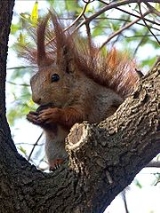
List of mammals in Ireland
Encyclopedia
This is a list of the mammal species recorded in Ireland. There are 55 mammal species in Ireland
. A new Red List of Irish terrestrial mammals was published in 2009 and all 26 terrestrial species native to Ireland, or naturalised in Ireland before 1500, were assessed. Of these, one was found to be regionally extinct (grey wolf Canis lupus), one achieved a threat status of Vulnerable (black rat Rattus rattus), three were found to be Near Threatened (Leisler's bat Nyctalus leisleri), otter (Lutra lutra) and red squirrel (Sciurus vulgaris)), one was data deficient (Brandt’s bat Myotis brandtii) and the remaining 20 were of least concern.
The following tags are used to highlight each species' conservation status as assessed by the IUCN
:
Order: Rodent
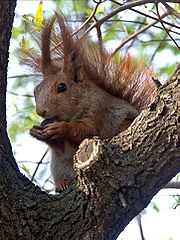 Rodents make up the largest order of mammals, with over 40 percent of mammalian species. They have two incisor
Rodents make up the largest order of mammals, with over 40 percent of mammalian species. They have two incisor
s in the upper and lower jaw which grow continually and must be keep short by gnawing. Most rodents are small though the capybara
can weigh up to 45 kg (100 lb).
Order: Lagomorpha
 The lagomorphs comprise two families, Leporidae
The lagomorphs comprise two families, Leporidae
(hare
s and rabbit
s), and Ochotonidae (pika
s). Though they can resemble rodent
s, and were classified as a superfamily
in that order until the early 20th century, they have since been considered a separate order. They differ from rodents in a number of physical characteristics, such as having four incisors in the upper jaw rather than two.
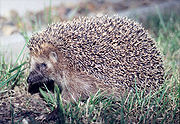 The order Erinaceomorpha contains a single family, Erinaceidae, which comprise the hedgehog
The order Erinaceomorpha contains a single family, Erinaceidae, which comprise the hedgehog
s and gymnure
s. The hedgehogs are easily recognised by their spines while gymnures look more like large rats.
Order: Soricomorpha
 The "shrew-forms" are insectivorous mammals. The shrews and soledons closely resemble mice while the moles are stout bodied burrowers.
The "shrew-forms" are insectivorous mammals. The shrews and soledons closely resemble mice while the moles are stout bodied burrowers.
 The bats' most distinguishing feature is that their forelimbs are developed as wings, making them the only mammals in the world naturally capable of flight. Bat species account for about 20% of all mammals.
The bats' most distinguishing feature is that their forelimbs are developed as wings, making them the only mammals in the world naturally capable of flight. Bat species account for about 20% of all mammals.
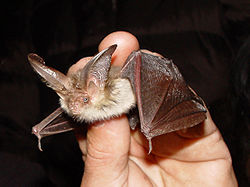
Order: Cetacea
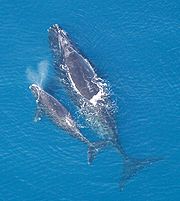
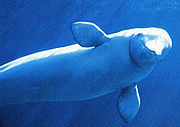
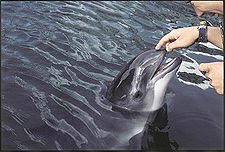
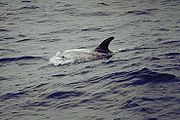
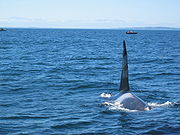 The order Cetacea includes whale
The order Cetacea includes whale
s, dolphin
s and porpoise
s. They are the mammals most fully adapted to aquatic
life with a spindle-shaped nearly hairless body, protected by a thick layer of blubber, and forelimbs and tail modified to provide propulsion underwater.
Order: Carnivora
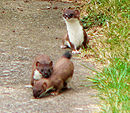
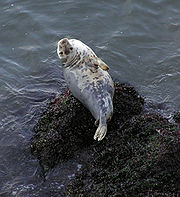 Carnivorans include over 260 species, the majority of which eat meat as their primary dietary item. They have a characteristic skull shape and dentition.
Carnivorans include over 260 species, the majority of which eat meat as their primary dietary item. They have a characteristic skull shape and dentition.
 The even-toed ungulates are ungulate
The even-toed ungulates are ungulate
s whose weight is borne about equally by the third and fourth toes, rather than mostly or entirely by the third as in perissodactyls. There are about 220 artiodactyl species, including many that are of great economic importance to human
s.
Ireland
Ireland is an island to the northwest of continental Europe. It is the third-largest island in Europe and the twentieth-largest island on Earth...
. A new Red List of Irish terrestrial mammals was published in 2009 and all 26 terrestrial species native to Ireland, or naturalised in Ireland before 1500, were assessed. Of these, one was found to be regionally extinct (grey wolf Canis lupus), one achieved a threat status of Vulnerable (black rat Rattus rattus), three were found to be Near Threatened (Leisler's bat Nyctalus leisleri), otter (Lutra lutra) and red squirrel (Sciurus vulgaris)), one was data deficient (Brandt’s bat Myotis brandtii) and the remaining 20 were of least concern.
The following tags are used to highlight each species' conservation status as assessed by the IUCN
World Conservation Union
The International Union for Conservation of Nature and Natural Resources is an international organization dedicated to finding "pragmatic solutions to our most pressing environment and development challenges." The organization publishes the IUCN Red List, compiling information from a network of...
:
| EX | Extinct | No reasonable doubt that the last individual has died. |
| EW | Extinct in the wild | Known only to survive in captivity or as a naturalized populations well outside its previous range. |
| RE | Regionally Extinct | The species is extinct in the wild in the region. |
| CR | Critically Endangered | The species is in imminent risk of extinction in the wild. |
| EN | Endangered | The species is facing an extremely high risk of extinction in the wild. |
| VU | Vulnerable | The species is facing a high risk of extinction in the wild. |
| NT | Near Threatened | The species does not meet any of the criteria that would categorise it as risking extinction but it is likely to do so in the future. |
| LC | Least Concern | There are no current identifiable risks to the species. |
| DD | Data Deficient | There is inadequate information to make an assessment of the risks to this species. |
Order: RodentRodentRodentia is an order of mammals also known as rodents, characterised by two continuously growing incisors in the upper and lower jaws which must be kept short by gnawing....
ia (rodents)

Incisor
Incisors are the first kind of tooth in heterodont mammals. They are located in the premaxilla above and mandible below.-Function:...
s in the upper and lower jaw which grow continually and must be keep short by gnawing. Most rodents are small though the capybara
Capybara
The capybara , also known as capivara in Portuguese, and capibara, chigüire in Venezuela, Colombia, and Ecuador ronsoco in Peru, chigüiro, and carpincho in Spanish, is the largest living rodent in the world. Its closest relatives are agouti, chinchillas, coyphillas, and guinea pigs...
can weigh up to 45 kg (100 lb).
- Suborder: SciurognathiSciurognathiSciurognathi is a suborder of rodents that includes squirrels, chipmunks, beavers, and many types of mice. The group is characterized by a specific shape to the lower jaw. In sciurognaths, the angular process of the jaw is in the same plane as the root of the incisors...
- Family: Sciuridae (squirrels)
- Subfamily: SciurinaeSciurinaeThe Sciurinae is a subfamily of squirrels in the . It unites the flying squirrels with certain related tree squirrels. Older sources place the flying squirrels in a separate subfamily and unite all remaining sciurids into the subfamily Sciurinae, but this has been strongly refuted by genetic...
- Genus: SciurusSciurusThe genus Sciurus contains most of the common, bushy-tailed squirrels in North America, Europe, temperate Asia, Central America and South America.-Species:There are 30 species.Genus Sciurus - Tree squirrels*Subgenus Sciurus...
- Red squirrelRed SquirrelThe red squirrel or Eurasian red squirrel is a species of tree squirrel in the genus Sciurus common throughout Eurasia...
Sciurus vulgaris NT. - Eastern grey squirrel Sciurus carolinensis not assessed - a recent introduction in 1911.
- Red squirrel
- Genus: Sciurus
- Subfamily: Sciurinae
- Family: CricetidaeCricetidaeThe Cricetidae are a family of rodents in the large and complex superfamily Muroidea. It includes true hamsters, voles, lemmings, and New World rats and mice...
- Subfamily: ArvicolinaeArvicolinaeThe Arvicolinae are a subfamily of rodents that includes the voles, lemmings, and muskrats. They are most closely related to the other subfamilies in the Cricetidae . Some authorities place the subfamily Arvicolinae in the family Muridae along with all other members of the superfamily Muroidea...
- Genus: Myodes
- Bank VoleBank VoleThe bank vole is a small vole with red-brown fur and some grey patches, with a tail about half as long as its body. A rodent, it lives in woodland areas and is around in length. The bank vole is found in western Europe and northern Asia...
Myodes glareolus not assessed - a recent introduction.
- Bank Vole
- Genus: Myodes
- Subfamily: Arvicolinae
- Family: MuridaeMuridaeMuridae is the largest family of mammals. It contains over 600 species found naturally throughout Eurasia, Africa, and Australia. They have been introduced worldwide. The group includes true mice and rats, gerbils, and relatives....
(mice, rats, etc.)- Subfamily: MurinaeMurinaeThe Old World rats and mice, part of the subfamily Murinae in the family Muridae, comprise at least 519 species. This subfamily is larger than all mammal families except the Cricetidae and Muridae, and is larger than all mammal orders except the bats and the remainder of the...
- Genus: Mus
- House mouseHouse mouseThe house mouse is a small rodent, a mouse, one of the most numerous species of the genus Mus.As a wild animal the house mouse mainly lives associated with humans, causing damage to crops and stored food....
Mus musculus LC. Very early introduction.
- House mouse
- Genus: ApodemusApodemusApodemus is the genus of Muridae which contains the Eurasian field mice. Related to the Ryūkyū spiny rats and the prehistoric Rhagamys – and far more distantly to Mus and Malacomys –, it includes the following species:*Striped Field Mouse, Apodemus agrarius*Alpine Field Mouse, Apodemus...
- Wood mouseWood mouseThe wood mouse is a common murid rodent from Europe and northwestern Africa. It is closely related to the yellow-necked mouse but differs in that it has no band of yellow fur around the neck, has slightly smaller ears, and is usually slightly smaller overall: around 90 mm in length...
Apodemus sylvaticus LC.
- Wood mouse
- Genus: Rattus
- Brown RatBrown RatThe brown rat, common rat, sewer rat, Hanover rat, Norway rat, Brown Norway rat, Norwegian rat, or wharf rat is one of the best known and most common rats....
Rattus norvegicus - not assessed; post 1500 introduction. - Black RatBlack RatThe black rat is a common long-tailed rodent of the genus Rattus in the subfamily Murinae . The species originated in tropical Asia and spread through the Near East in Roman times before reaching Europe by the 1st century and spreading with Europeans across the world.-Taxonomy:The black rat was...
Rattus rattus - VU; a very early (pre-1500) introduction.
- Brown Rat
- Genus: Mus
- Subfamily: Murinae
- Family: Sciuridae (squirrels)
Order: LagomorphaLagomorphaThe lagomorphs are the members of the taxonomic order Lagomorpha, of which there are two living families, the Leporidae , and the Ochotonidae...
(lagomorphs)

Leporidae
Leporids are the approximately 50 species of rabbits and hares which form the family Leporidae. The leporids, together with the pikas, constitute the mammalian order Lagomorpha. Leporids differ from pikas in having short furry tails, and elongated ears and hind legs...
(hare
Hare
Hares and jackrabbits are leporids belonging to the genus Lepus. Hares less than one year old are called leverets. Four species commonly known as types of hare are classified outside of Lepus: the hispid hare , and three species known as red rock hares .Hares are very fast-moving...
s and rabbit
Rabbit
Rabbits are small mammals in the family Leporidae of the order Lagomorpha, found in several parts of the world...
s), and Ochotonidae (pika
Pika
The pika is a small mammal, with short limbs, rounded ears, and short tail. The name pika is used for any member of the Ochotonidae, a family within the order of lagomorphs, which also includes the Leporidae . One genus, Ochotona, is recognised within the family, and it includes 30 species...
s). Though they can resemble rodent
Rodent
Rodentia is an order of mammals also known as rodents, characterised by two continuously growing incisors in the upper and lower jaws which must be kept short by gnawing....
s, and were classified as a superfamily
Taxonomic rank
In biological classification, rank is the level in a taxonomic hierarchy. Examples of taxonomic ranks are species, genus, family, and class. Each rank subsumes under it a number of less general categories...
in that order until the early 20th century, they have since been considered a separate order. They differ from rodents in a number of physical characteristics, such as having four incisors in the upper jaw rather than two.
- Family: LeporidaeLeporidaeLeporids are the approximately 50 species of rabbits and hares which form the family Leporidae. The leporids, together with the pikas, constitute the mammalian order Lagomorpha. Leporids differ from pikas in having short furry tails, and elongated ears and hind legs...
(rabbits, hares)- Genus: Oryctolagus
- European RabbitEuropean RabbitThe European Rabbit or Common Rabbit is a species of rabbit native to south west Europe and north west Africa . It has been widely introduced elsewhere often with devastating effects on local biodiversity...
Oryctolagus cuniculus LC - an early introduction c. 1100s.
- European Rabbit
- Genus: LepusHareHares and jackrabbits are leporids belonging to the genus Lepus. Hares less than one year old are called leverets. Four species commonly known as types of hare are classified outside of Lepus: the hispid hare , and three species known as red rock hares .Hares are very fast-moving...
- Irish HareMountain HareThe Mountain Hare , also known as Blue Hare, Tundra Hare, Variable Hare, White Hare, Alpine Hare and Irish Hare, is a hare, which is largely adapted to polar and mountainous habitats. It is distributed from Fennoscandia to eastern Siberia; in addition there are isolated populations in the Alps,...
Lepus timidus LC. - European HareEuropean HareThe European hare , also known as the brown hare, Eastern Jackrabbit and Eastern prairie hare, is a species of hare native to northern, central, and western Europe and western Asia. It is a mammal adapted to temperate open country. It is related to the similarly appearing rabbit, which is in the...
Lepus europaeus - not assessed; recent introduction.
- Irish Hare
- Genus: Oryctolagus
Order: Erinaceomorpha (hedgehogs and gymnures)

Hedgehog
A hedgehog is any of the spiny mammals of the subfamily Erinaceinae and the order Erinaceomorpha. There are 17 species of hedgehog in five genera, found through parts of Europe, Asia, Africa, and New Zealand . There are no hedgehogs native to Australia, and no living species native to the Americas...
s and gymnure
Gymnure
The gymnure, also called a hairy hedgehog or moonrat, is a type of mammal belonging to the subfamily Galericinae, in the family Erinaceidae and the order Erinaceomorpha...
s. The hedgehogs are easily recognised by their spines while gymnures look more like large rats.
- Family: ErinaceidaeErinaceidaeErinaceidae is the only living family in the order Erinaceomorpha, which has recently been subsumed with Soricomorpha into the order Eulipotyphla...
(hedgehogs)- Subfamily: Erinaceinae
- Genus: ErinaceusErinaceusErinaceus is a genus of European hedgehog from the family of Erinaceidae. There are four main species of Erinaceus. The range is all across Europe, throughout the Middle East, parts of Russia, and extending to northern China...
- West European Hedgehog Erinaceus europaeus LC.
- Genus: Erinaceus
- Subfamily: Erinaceinae
Order: SoricomorphaSoricomorphaThe order Soricomorpha is taxon within the class of mammals. In previous years it formed a significant group within the former order Insectivora...
(shrews, moles, and soledons)

- Family: Soricidae (shrews)
- Subfamily: Soricinae
- Genus: SorexSorexThe genus Sorex includes many of the common shrews of Eurasia and North America. Members of this genus, known as long-tailed shrews, are the only members of the tribe Soricini of the subfamily Soricinae...
- Eurasian Pygmy ShrewEurasian pygmy shrewThe Eurasian Pygmy Shrew , often known simply as the Pygmy Shrew, is a widespread shrew of northern Eurasia. It is the only shrew native to Ireland....
Sorex minutus LC.
- Eurasian Pygmy Shrew
- Genus: CrociduraCrociduraThe genus Crocidura is one of nine genus of the shrew subfamily Crocidurinae. Members of the genus are commonly called white-toothed shrews or musk shrews, although both also apply to all of the species in the subfamily. With 182 species, Crocidura contains the largest number of species of any...
- Greater White-toothed ShrewGreater white-toothed shrewThe Greater White-toothed Shrew is a small insectivorous mammal. found in Europe and North Africa, weighing about 11-14 grams...
Crocidura russula not assessed a very recent introduction.
- Greater White-toothed Shrew
- Genus: Sorex
- Subfamily: Soricinae
Order: Chiroptera (bats)

- Family: Vespertilionidae
- Subfamily: Myotinae
- Genus: Myotis
- Daubenton's BatDaubenton's batDaubenton's Bat, Myotis daubentonii, is a Eurasian bat with quite short ears. It ranges from Britain to Japan and is considered to be increasing its numbers in many areas.The name commemorates the French naturalist Louis-Jean-Marie Daubenton....
Myotis daubentonii LC. - Whiskered BatWhiskered batThe whiskered bats Myotis mystacinus and related species, are small European bats with long fur. Although uncommon, M. mystacinus is often found around human habitation and around water; it is similar to Brandt's bat Myotis brandtii, from which it was distinguished as a separate species only in...
Myotis mystacinus LC. - Brandt's BatBrandt's BatBrandt's Bat is a species of vesper bat in the Vespertilionidae family.It is found throughout most of Europe and parts of Asia.It is named for the German zoologist Johann Friedrich von Brandt.-Echolocation:...
Myotis brandti DD. - Natterer's BatNatterer's batNatterer's bat is a European bat with pale wings. It has brown fur, also seen on the leg wing membrane, tending to white on its underside...
Myotis nattereri LC.
- Daubenton's Bat
- Genus: Myotis
- Subfamily: VespertilioninaeVespertilioninaeVespertilioninae is a subfamily of Vesper Bats from the family Vespertilionidae.-Classification:Subfamily Vespertilioninae*Tribe Eptesicini**Genus Arielulus***Collared Pipistrelle, Arielulus aureocollaris...
- Genus: NyctalusNyctalusThe bat genus Nyctalus are members of the family Vespertilionidae or sometimes Evening bats. They are distributed in the temperate and subtropical areas of Europe, Asia and North Africa.There are eight species within this genus:...
- Genus: Nyctalus
- Subfamily: Myotinae

-
-
-
- Leisler's Bat Nyctalus leisleri NT.
- Genus: PipistrellusPipistrellusPipistrellus is a genus of bats in the family Vespertilionidae and subfamily Vespertilioninae. The name of the genus is derived from the Italian word Pipistrello, meaning "bat"....
- Common PipistrelleCommon PipistrelleThe Common Pipistrelle Pipistrellus pipistrellus is a small pipistrelle bat whose very large range extends across most of Europe, North Africa, southwestern Asia, and possibly into Korea. It is one of the most common bat species in the British Isles....
Pipistrellus pipistrellus LC. - Soprano PipistrelleSoprano PipistrelleThe Soprano Pipistrelle is a small bat that was only formally separated from the Common Pipistrelle Pipistrellus pipistrellus in 1999....
Pipistrellus pygmaeus LC. - Nathusius Pipistrelle Pipistrellus nathusii LC.
- Common Pipistrelle
- Genus: PlecotusPlecotusThe genus Plecotus consists of the lump-nosed bats. Many species in the genus have only been described and recognized in recent years.-Species:Genus Plecotus - Lump-nosed bats*Plecotus ariel*Brown Long-eared Bat, Plecotus auritus...
- Brown Long-eared BatBrown long-eared batThe brown long-eared bat or common long-eared bat is a fairly large European bat. It has distinctive ears, long and with a distinctive fold...
Plecotus auritus LC.
- Brown Long-eared Bat
-
-
- Family: Rhinolophidae
- Subfamily: Rhinolophinae
- Genus: Rhinolophus
- Lesser Horseshoe BatLesser horseshoe batThe Lesser Horseshoe Bat , is a type of European bat related to but smaller than its cousin, the Greater Horseshoe Bat...
Rhinolophus hipposideros LC.
- Lesser Horseshoe Bat
- Genus: Rhinolophus
- Subfamily: Rhinolophinae
Order: CetaceaCetaceaThe order Cetacea includes the marine mammals commonly known as whales, dolphins, and porpoises. Cetus is Latin and is used in biological names to mean "whale"; its original meaning, "large sea animal", was more general. It comes from Ancient Greek , meaning "whale" or "any huge fish or sea...
(whales)





Whale
Whale is the common name for various marine mammals of the order Cetacea. The term whale sometimes refers to all cetaceans, but more often it excludes dolphins and porpoises, which belong to suborder Odontoceti . This suborder also includes the sperm whale, killer whale, pilot whale, and beluga...
s, dolphin
Dolphin
Dolphins are marine mammals that are closely related to whales and porpoises. There are almost forty species of dolphin in 17 genera. They vary in size from and , up to and . They are found worldwide, mostly in the shallower seas of the continental shelves, and are carnivores, mostly eating...
s and porpoise
Porpoise
Porpoises are small cetaceans of the family Phocoenidae; they are related to whales and dolphins. They are distinct from dolphins, although the word "porpoise" has been used to refer to any small dolphin, especially by sailors and fishermen...
s. They are the mammals most fully adapted to aquatic
Aquatic adaptation
Several animal groups have undergone aquatic adaptation, going from being purely terrestrial animals to living at least part of the time in water. The adaptations in early speciation tend to develop as the animal ventures into water in order to find available food. As successive generations spend...
life with a spindle-shaped nearly hairless body, protected by a thick layer of blubber, and forelimbs and tail modified to provide propulsion underwater.
- Suborder: Mysticeti
- Family: BalaenidaeBalaenidaeBalaenidae is a family of mysticete whales that contains two living genera. Commonly called the right whales as it contains mainly right whale species...
- Genus: Eubalaena
- North Atlantic Right WhaleNorth Atlantic Right WhaleThe North Atlantic right whale which means "good, or true, whale of the ice") is a baleen whale, one of three right whale species belonging to the genus Eubalaena, formerly classified as a single species. With only 400 in existence, North Atlantic right whales are among the most endangered whales...
Eubalaena glacialis EN
- North Atlantic Right Whale
- Genus: Eubalaena
- Family: Balaenopteridae
- Subfamily: Balaenopterinae
- Genus: BalaenopteraBalaenopteraBalaenoptera is a genus of Balaenopteridae, the Rorqual whales, and contains eight species. The species Balaenoptera omurai was published in 2003...
- Fin WhaleFin WhaleThe fin whale , also called the finback whale, razorback, or common rorqual, is a marine mammal belonging to the suborder of baleen whales. It is the second longest whale and the sixth largest living animal after the blue whale, bowhead whale, and right whales, growing to nearly 27 metres long...
Balaenoptera physalis - Minke WhaleMinke WhaleMinke whale , or lesser rorqual, is a name given to two species of marine mammal belonging to a clade within the suborder of baleen whales. The minke whale was given its official designation by Lacepède in 1804, who described a dwarf form of Balænoptera acuto-rostrata...
Balaenoptera acutorostrata LR/NT - Sei WhaleSei WhaleThe sei whale , Balaenoptera borealis, is a baleen whale, the third-largest rorqual after the blue whale and the fin whale. It inhabits most oceans and adjoining seas, and prefers deep offshore waters. It avoids polar and tropical waters and semi-enclosed bodies of water...
Balaenoptera borealis - Blue WhaleBlue WhaleThe blue whale is a marine mammal belonging to the suborder of baleen whales . At in length and or more in weight, it is the largest known animal to have ever existed....
Balaenoptera musculus
- Fin Whale
- Genus: Megaptera
- Humpback whaleHumpback WhaleThe humpback whale is a species of baleen whale. One of the larger rorqual species, adults range in length from and weigh approximately . The humpback has a distinctive body shape, with unusually long pectoral fins and a knobbly head. It is an acrobatic animal, often breaching and slapping the...
Megaptera novaeangliae
- Humpback whale
- Genus: Balaenoptera
- Subfamily: Balaenopterinae
- Family: Balaenidae
- Suborder: Odontoceti
- Superfamily: Platanistoidea
- Family: MonodontidaeMonodontidaeThe cetacean family Monodontidae comprises two unusual whale species, the narwhal, in which the male has a long tusk, and the white beluga whale...
- Genus: Delphinapterus
- Beluga Delphinapterus leucas VU
- Genus: Delphinapterus
- Family: Phocoenidae
- Genus: Phocoena
- Harbour PorpoiseHarbour PorpoiseThe harbour porpoise is one of six species of porpoise. It is one of the smallest marine mammals. As its name implies, it stays close to coastal areas or river estuaries, and as such, is the most familiar porpoise to whale watchers. This porpoise often ventures up rivers, and has been seen...
Phocoena phocoena VU
- Harbour Porpoise
- Genus: Phocoena
- Family: Physeteridae
- Genus: Physeter
- Sperm WhaleSperm WhaleThe sperm whale, Physeter macrocephalus, is a marine mammal species, order Cetacea, a toothed whale having the largest brain of any animal. The name comes from the milky-white waxy substance, spermaceti, found in the animal's head. The sperm whale is the only living member of genus Physeter...
Physeter macrocephalus VU
- Sperm Whale
- Genus: Physeter
- Family: Kogiidae
- Genus: Kogia
- Pygmy Sperm WhalePygmy Sperm WhaleThe Pygmy Sperm Whale is one of three species of toothed whale in the sperm whale family. They are not often sighted at sea, and most of what is known about them comes from the examination of stranded specimens.-Taxonomy:...
Kogia breviceps LR/LC
- Pygmy Sperm Whale
- Genus: Kogia
- Family: Ziphidae
- Genus: Ziphius
- Cuvier's Beaked WhaleCuvier's Beaked WhaleCuvier's beaked whale is the most widely distributed of all the beaked whales. It is the only member of the genus Ziphius. Another common name for the species is goose-beaked whale because its head is said to be shaped like the beak of a goose. Georges Cuvier first described it in 1823 from part...
Ziphius cavirostris DD
- Cuvier's Beaked Whale
- Genus: Ziphius
- Subfamily: Hyperoodontidae
- Genus: Hyperoodon
- Bottlenose whaleBottlenose whaleThe Northern bottlenose whale is a species of the ziphiid family, one of two members of the Hyperoodon genus. The northern bottlenose was hunted heavily by Norway and Britain in the 19th and early 20th centuries...
Hyperoodon ampullatus LR/CD
- Bottlenose whale
- Genus: Mesoplodon
- Sowerby's Beaked WhaleSowerby's Beaked WhaleSowerby's beaked whale , also known as the North Atlantic/North Sea beaked whale, was the first beaked whale to be described. James Sowerby, an English naturalist and artist, first described the species in 1804 from a skull obtained from a male that had stranded in the Moray Firth, Scotland, in 1800...
Mesoplodon bidens DD - Gervais' Beaked WhaleGervais' Beaked WhaleGervais' beaked whale , sometimes known as the Antillian beaked whale, Gulf Stream beaked whale, or European beaked whale is the most frequently stranding type of mesoplodont whale off the coast of North America...
Mesoplodon europaeus DD - True's Beaked WhaleTrue's Beaked WhaleThe True's Beaked Whale is a medium sized whale in the Mesoplodont genus. The common name is in reference to Frederick W. True, a curator at the United States National Museum...
Mesoplodon mirus DD
- Sowerby's Beaked Whale
- Genus: Hyperoodon
- Family: Delphinidae (marine dolphins)
- Genus: DelphisDelphisDelphis is a belgian shipping company which has a fleet of 50 container ships with a total capacity of . In 2006 Delphis acquired rival companies Team Lines and Portlink and the new formed group moved in the same year....
- Short-beaked Common DolphinShort-beaked Common DolphinThe short-beaked common dolphin is a species of common dolphin. It has a larger range than the long-beaked common dolphin , occurring throughout warm-temperate and tropical oceans, with the possible exception of the Indian Ocean...
Delphinus delphis
- Short-beaked Common Dolphin
- Genus: Tursiops
- Bottlenose DolphinBottlenose DolphinBottlenose dolphins, the genus Tursiops, are the most common and well-known members of the family Delphinidae, the family of oceanic dolphins. Recent molecular studies show the genus contains two species, the common bottlenose dolphin and the Indo-Pacific bottlenose dolphin , instead of one...
Tursiops truncatus DD
- Bottlenose Dolphin
- Genus: StenellaStenellaStenella is a genus of aquatic mammals in Delphinidae, the family informally known as the oceanic dolphins.Currently five species are recognised in this genus:*Pantropical Spotted Dolphin, S. attenuata*Atlantic Spotted Dolphin, S. frontalis...
- Striped DolphinStriped DolphinThe Striped Dolphin is an extensively studied dolphin that is found in temperate and tropical waters of all the world's oceans.-Taxonomy:...
Stenella coeruleoalba LR/cd
- Striped Dolphin
- Genus: LagenorhynchusLagenorhynchusLagenorhynchus is a genus in the order Cetacea, traditionally containing six species:* white-beaked dolphin, Lagenorhynchus albirostris* Atlantic white-sided dolphin, Lagenorhynchus acutus...
- Atlantic White-sided DolphinAtlantic White-sided DolphinThe Atlantic White-sided Dolphin is a distinctively coloured dolphin found in the cool to temperate waters of the North Atlantic Ocean.-Taxonomy:...
Lagenorhynchus acutus LR/LC - White-beaked DolphinWhite-beaked DolphinThe White-beaked dolphin is a marine mammal belonging to the family Delphinidae in the suborder Odontoceti .-Taxonomy:...
Lagenorhynchus albirostris LR/LC
- Atlantic White-sided Dolphin
- Genus: Grampus
- Risso's DolphinRisso's DolphinRisso's dolphin is the only species of dolphin in the genus Grampus.-Taxonomy:Risso's dolphin is named after Antoine Risso, whose description formed the basis of the first public description of the animal, by Georges Cuvier, in 1812...
Grampus griseus DD
- Risso's Dolphin
- Genus: Orcinus
- OrcaOrcaThe killer whale , commonly referred to as the orca, and less commonly as the blackfish, is a toothed whale belonging to the oceanic dolphin family. Killer whales are found in all oceans, from the frigid Arctic and Antarctic regions to tropical seas...
Orcinus orca LR/CD
- Orca
- Genus: Globicephala
- Pilot whalePilot whalePilot whales are cetaceans belonging to the genus Globicephala. There are two extant species, the long-finned pilot whale and the short-finned pilot whale . The two are not readily distinguished at sea and analysis of the skulls is the best way to tell the difference between them...
Globicephala melas LR/LC
- Pilot whale
- Genus: Pseudorca
- False Killer WhaleFalse Killer WhaleThe False Killer Whale is a cetacean, and the third largest member of the oceanic dolphin family . It lives in temperate and tropical waters throughout the world. As its name implies, the False Killer Whale shares characteristics, such as appearance, with the more widely known Orca...
Pseudorca crassidens
- False Killer Whale
- Genus: Delphis
- Family: Monodontidae
- Superfamily: Platanistoidea
Order: CarnivoraCarnivoraThe diverse order Carnivora |Latin]] carō "flesh", + vorāre "to devour") includes over 260 species of placental mammals. Its members are formally referred to as carnivorans, while the word "carnivore" can refer to any meat-eating animal...
(carnivorans)


- Suborder: CaniformiaCaniformiaCaniformia, or Canoidea , is a suborder within the order Carnivora. They typically possess a long snout and non-retractile claws . The Pinnipedia evolved from caniform ancestors and are accordingly assigned to this group...
- Family: CanidaeCanidaeCanidae is the biological family of carnivorous and omnivorous mammals that includes wolves, foxes, jackals, coyotes, and domestic dogs. A member of this family is called a canid . The Canidae family is divided into two tribes: Canini and Vulpini...
(dogs, foxes)- Genus: VulpesVulpesVulpes is a genus of the Canidae family. Its members are referred to as 'true foxes', although there are species in other genera whose common names include the word 'fox'....
- Red FoxRed FoxThe red fox is the largest of the true foxes, as well as being the most geographically spread member of the Carnivora, being distributed across the entire northern hemisphere from the Arctic Circle to North Africa, Central America, and the steppes of Asia...
Vulpes vulpes LC.
- Red Fox
- Genus: CanisCanisCanis is a genus containing 7 to 10 extant species, including dogs, wolves, coyotes, and jackals, and many extinct species.-Wolves, dogs and dingos:Wolves, dogs and dingos are subspecies of Canis lupus...
- Grey WolfGray WolfThe gray wolf , also known as the wolf, is the largest extant wild member of the Canidae family...
Canis lupus RE - the last wolf in IrelandIrish wolfWolves were once an integral part of the Irish countryside and culture. The earliest radiocarbon date for Irish wolf remains come from excavated cave sites in Castlepook Cave, north of Doneraile, county Cork, and date back to 34,000BP...
was killed in 1783
- Grey Wolf
- Genus: Vulpes
- Family: MustelidaeMustelidaeMustelidae , commonly referred to as the weasel family, are a family of carnivorous mammals. Mustelids are diverse and the largest family in the order Carnivora, at least partly because in the past it has been a catch-all category for many early or poorly differentiated taxa...
(mustelids)- Genus: NeovisonNeovisonA genus of Mustelids, including the extinct sea mink and the extant American mink....
- American MinkAmerican MinkThe American mink is a semi-aquatic species of Mustelid native to North America, though human intervention has expanded its range to many parts of Europe and South America. Because of this, it is classed as Least Concern by the IUCN. Since the extinction of the sea mink, the American mink is the...
Neovison vison not assessed.
- American Mink
- Genus: Mustela
- StoatStoatThe stoat , also known as the ermine or short-tailed weasel, is a species of Mustelid native to Eurasia and North America, distinguished from the least weasel by its larger size and longer tail with a prominent black tip...
Mustela erminea LC.
- Stoat
- Genus: Martes
- European Pine Marten Martes martes LC.
- Genus: MelesMeles (genus)Meles is a genus of badgers, containing three living species, the Japanese Badger , Asian Badger , and European Badger ....
- Eurasian BadgerEurasian BadgerThe European Badger is a species of badger of the genus Meles, native to almost all of Europe. It is classed as Least Concern for extinction by the IUCN, due to its wide distribution and large population....
Meles meles LC.
- Eurasian Badger
- Genus: LutraLutraLutra is a genus of otters.*Lutra nippon - Japanese otter*Lutra sumatrana - Hairy-nosed otter*Lutra lutra - European otter-Habitat:Lutra are semi-aquatic mammals and therefore need to be well-adapted to both water and land...
- European OtterEuropean OtterThe European Otter , also known as the Eurasian otter, Eurasian river otter, common otter and Old World otter, is a European and Asian member of the Lutrinae or otter subfamily, and is typical of freshwater otters....
Lutra lutra NT.
- European Otter
- Genus: Neovison
- Family: OdobenidaeOdobenidaeOdobenidae is a family of Pinnipeds. The only living species is walrus.In the past, however, the group was much more diverse, and includes more than ten fossil genera.- Taxonomy :All genera, except Odobenus, are extinct.*Prototaria...
- Genus: Odobenus
- WalrusWalrusThe walrus is a large flippered marine mammal with a discontinuous circumpolar distribution in the Arctic Ocean and sub-Arctic seas of the Northern Hemisphere. The walrus is the only living species in the Odobenidae family and Odobenus genus. It is subdivided into three subspecies: the Atlantic...
Odobenus rosmarus LR/LC
- Walrus
- Genus: Odobenus
- Family: Phocidae (earless seals)
- Genus: Halichoerus
- Grey SealGrey SealThe grey seal is found on both shores of the North Atlantic Ocean. It is a large seal of the family Phocidae or "true seals". It is the only species classified in the genus Halichoerus...
Halichoerus grypus LR/LC
- Grey Seal
- Genus: PhocaPhocaPhoca is a genus of the earless seals, within the Family Phocidae. It now contains just two species, the Common Seal and the Spotted Seal...
- Common Seal Phoca vitulina LR/LC
- Genus: Halichoerus
- Family: Ursidae
- Genus: UrsusUrsus (genus)Ursus is a genus in the family Ursidae that includes the widely distributed brown bears, the polar bear, and black bears. The name is derived from the Latin ursus, meaning bear.-Species and subspecies of Ursus:...
- Brown BearBrown BearThe brown bear is a large bear distributed across much of northern Eurasia and North America. It can weigh from and its largest subspecies, the Kodiak Bear, rivals the polar bear as the largest member of the bear family and as the largest land-based predator.There are several recognized...
Ursus arctos not assessed - extirpated 11th century
- Brown Bear
- Genus: Ursus
- Family: Canidae
Order: Artiodactyla (even-toed ungulates)

Ungulate
Ungulates are several groups of mammals, most of which use the tips of their toes, usually hoofed, to sustain their whole body weight while moving. They make up several orders of mammals, of which six to eight survive...
s whose weight is borne about equally by the third and fourth toes, rather than mostly or entirely by the third as in perissodactyls. There are about 220 artiodactyl species, including many that are of great economic importance to human
Human
Humans are the only living species in the Homo genus...
s.
- Family: SuidaeSuidaeSuidae is the biological family to which pigs belong. In addition to numerous fossil species, up to sixteen extant species are currently recognized, classified into between four and eight genera...
(pigs)- Subfamily: SuinaeSuinaeSuinae is a subfamily of mammals that includes at least some of the living members of the family Suidae and their closest relatives—the domestic pig and related species, such as babirusas. Several extinct species within Suidae are classified in subfamilies other than Suinae...
- Genus: SusPigA pig is any of the animals in the genus Sus, within the Suidae family of even-toed ungulates. Pigs include the domestic pig, its ancestor the wild boar, and several other wild relatives...
- BoarBoarWild boar, also wild pig, is a species of the pig genus Sus, part of the biological family Suidae. The species includes many subspecies. It is the wild ancestor of the domestic pig, an animal with which it freely hybridises...
Sus scrofa
- Boar
- Genus: Sus
- Subfamily: Suinae
- Family: Cervidae (deer)
- Subfamily: CervinaeCervinaeCervinae or the Old World deer , is a subfamily of deer. Alternatively, they're known as the Plesiometacarpal deer, due to their ankle structure being different from the Telemetecarpal deer of Capreolinae-Classification and Species:The list is based on the studies of Randi, Mucci, Claro-Hergueta,...
- Genus: CervusCervusCervus is a genus of deer that primarily are native to Eurasia, although one species occurs in northern Africa and another in North America. In addition to the species presently placed in this genus, it has included a whole range of other species now commonly placed in other genera, but some of...
- Red DeerRed DeerThe red deer is one of the largest deer species. Depending on taxonomy, the red deer inhabits most of Europe, the Caucasus Mountains region, Asia Minor, parts of western Asia, and central Asia. It also inhabits the Atlas Mountains region between Morocco and Tunisia in northwestern Africa, being...
Cervus elaphus - Sika DeerSika DeerThe Sika Deer, Cervus nippon, also known as the Spotted Deer or the Japanese Deer, is a species of deer native to much of East Asia and introduced to various other parts of the world...
Cervus nipppon not assessed - recent introduction. - Reeves's MuntjacReeves's MuntjacThe Reeves' Muntjac is a muntjac species found widely in southeastern China and in Taiwan. They have also been introduced in the Netherlands, the United Kingdom and Ireland by 2008. It feeds on herbs, blossoms, succulent shoots, grasses and nuts, and was also reported to eat trees...
Muntiacus reevesi not assessed - recent introduction
- Red Deer
- Genus: Cervus
- Subfamily: CapreolinaeCapreolinaeCapreolinae, also known as Odocoileinae or the New World deer , is a subfamily of deer...
- Genus: CapreolusCapreolusCapreolus is a genus of deer with at least two extant species:* Capreolus capreolus * Capreolus pygargus...
- Roe DeerRoe DeerThe European Roe Deer , also known as the Western Roe Deer, chevreuil or just Roe Deer, is a Eurasian species of deer. It is relatively small, reddish and grey-brown, and well-adapted to cold environments. Roe Deer are widespread in Western Europe, from the Mediterranean to Scandinavia, and from...
Capreolus capreolus Not assessed. No longer present. Introduced to the Lissadell Estate, Co. Sligo in 1870. Died out circa 1920.
- Roe Deer
- Genus: DamaDamaDama is a village in southern Syria, in As Suwaydā' Governorate. It is located in the heart of the Lejah lava plateau, 29 km north west of the city of As Suwayda....
- Fallow DeerFallow DeerThe Fallow Deer is a ruminant mammal belonging to the family Cervidae. This common species is native to western Eurasia, but has been introduced widely elsewhere. It often includes the rarer Persian Fallow Deer as a subspecies , while others treat it as an entirely different species The Fallow...
Dama dama
- Fallow Deer
- Genus: Capreolus
- Subfamily: Cervinae
- Family: Bovidae
- Subfamily: Caprinae
- Genus: CapraCapra (genus)Capra is a genus of mammals, the goats or wild goats, composed of up to nine species including the wild goat, the markhor and several species known as ibex....
- Feral Bilberry goat Capra aegagrus hircus Not assessed as derived from domesticated animals.
- Genus: Capra
- Subfamily: Caprinae
See also
- List of chordate orders
- List of regional mammals lists
- List of prehistoric mammals
- Mammal classificationMammal classificationMammalia is a class of animal within the Phylum Chordata. Mammal classification has been through several iterations since Carolus Linnaeus initially defined the class. Many earlier ideas have been completely abandoned by modern taxonomists, among these are the idea that bats are related to birds...
- New mammal species
- List of butterflies of Ireland
Comparison with Great Britain
The following species are found in Great Britain but not in Ireland:- Field VoleField VoleThe field vole or short-tailed vole, Microtus agrestis, is a grey-brown vole, around 110mm in length, with only a short tail. They are one of the most common mammals in Europe, ranging from the Atlantic coast to Lake Baikal. They are found in moist grassy habitats, such as woodland, marsh, or...
Microtus agrestis - Common VoleCommon VoleThe Common Vole, Microtus arvalis, is a European mammal.- Distribution and habitat :The common vole is hardly restricted in means of distribution and habitat and inhabits large areas of Eurasia. As Microtus arvalis followed human civilisation, primary and secondary habitats can be distinguished...
M. arvalis - Water Vole Arvicola terrestris
- Harvest Mouse Micromys minutus
- Yellow-necked MouseYellow-necked mouseThe Yellow-necked Mouse Apodemus flavicollis is closely related to the wood mouse, with which it was long confused, only being recognised as a separate species in 1894. It differs in its band of yellow fur around the neck and in having slightly larger ears and usually being slightly larger overall....
A. flavicollis - Hazel DormouseHazel DormouseThe Hazel Dormouse or Common Dormouse is a small mammal and the only living species in the genus Muscardinus....
Muscardinus avellanarius - Edible DormouseEdible dormouseThe edible dormouse or fat dormouse is a large dormouse and the only living species in the genus Glis.-Description:...
Glis glis - European MoleEuropean MoleThe European Mole, Talpa europaea, is a mammal of the order Soricomorpha. It is also known as the Common Mole and the Northern Mole....
Talpa europaea - Common ShrewCommon ShrewThe Common Shrew or Eurasian Shrew, Sorex araneus, is the most common shrew, and one of the most common mammals, throughout Northern Europe, including Great Britain, but excluding Ireland. It is long and weighs , and has velvety dark brown fur with a pale underside. Juvenile shrews have lighter...
Sorex araneus - Eurasian Water ShrewEurasian Water ShrewThe Eurasian Water Shrew, Neomys fodiens, known in the United Kingdom as the Water Shrew, is a relatively large shrew, up to long, with a tail up to three-quarters as long again. It has short dark fur, often with a few white tufts, a white belly, and a few stiff hairs around the feet and tail...
Neomys fodiens - Lesser White-toothed ShrewLesser white-toothed shrewThe Lesser White-toothed Shrew is a tiny shrew with a widespread distribution in Africa, Asia and Europe, but not in most of Spain, north–west France and mainland Great Britain. Its preferred habitat is scrub and gardens and it feeds on insects, worms, slugs, snails and small mice...
Crocidura suaveolens - Greater Horseshoe BatGreater Horseshoe BatThe Greater Horseshoe Bat is a European bat of the Rhinolophus genus. Its distribution covers Europe, Africa, South Asia and Australia. It is the largest of the European Horseshoe Bats and is thus easily distinguished from other species...
Rhinolophus ferrumequinum - Greater Mouse-eared BatGreater mouse-eared batThe greater mouse-eared bat, Myotis myotis, is a European species of bat in the Vespertilionidae family.-Description:It is relatively large for a member of the Myotis genus, weighing up to , making it one of the largest European bats.-Foraging:Like its relatives it eats various arthropods;...
Myotis myotis - Bechstein's BatBechstein's BatBechstein's Bat is a species of vesper bat in the Vespertilionidae family.It can be found in the following countries: Austria, Armenia, Belarus, Belgium, Bosnia and Herzegovina, Bulgaria, Croatia, Czech Republic, France, Georgia, Germany, Hungary, Iran, Italy, Liechtenstein, Republic of Macedonia,...
M. bechsteini - Parti-coloured BatParti-coloured batThe Parti-coloured Bat or Rearmouse is a species of bats in the family of Vesper bats. It is a medium sized bat.- Description :...
Vespertilio murinus - Serotine Eptesicus serotinus
- Northern BatNorthern BatThe Northern Bat is a species of bat. An adult Northern Bat has a body length of 4.9-6.6 cm, a tail of 3.2-5.1 cm, and a wing length of 4.1-5.1 cm. The species is found across Europe and Asia, from England to Hokkaidō and south to northern India.-References: 2006 IUCN Red List of Threatened...
E. nilssoni - Common NoctuleCommon NoctuleThe Common Noctule is a species of bat common throughout Europe, Asia, and North Africa. The UK distribution can be found on the National Biodiversity Network website ....
Nyctalus noctula - Hoary BatHoary batThe hoary bat is a species of bat in the vesper bat family, Vespertilionidae. It occurs throughout most of North America and much of South America, with disjunct populations in the Galapagos and Hawaiian Islands...
Lasiurus cinereus - BarbastelleBarbastelleThe Barbastelle , also known as the Western Barbastelle, is a European bat. It has a short nose, small eyes and wide ears.It is rare throughout its range...
Barbastella barbastellus - Grey Long-eared BatGrey long-eared batThe grey long-eared bat is a fairly large European bat. It has distinctive ears, long and with a distinctive fold. It hunts above woodland, often by day, and mostly for moths. It is extremely similar to the more common brown long-eared bat, and was only distinguished in the 1960s, but has a...
Plecotus austriacus - Ringed SealRinged SealThe ringed seal , also known as the jar seal and as netsik or nattiq by the Inuit, is an earless seal inhabiting the Arctic and sub-Arctic regions...
Phoca hispida - Bearded SealBearded SealThe bearded seal , also called the square flipper seal, is a medium-sized pinniped that is found in and near to the Arctic Ocean. It gets its generic name from two Greek words that refer to its heavy jaw...
Erignathus barbatus - Hooded SealHooded SealThe hooded seal is an arctic pinniped found only in the central and western North Atlantic ranging from Svalbard in the east to the Gulf of St...
Cystophora cristatus - Harp SealHarp SealThe harp seal or saddleback seal is a species of earless seal native to the northernmost Atlantic Ocean and adjacent parts of the Arctic Ocean. It now belongs to the monotypic genus Pagophilus. Its scientific name, Pagophilus groenlandicus, means "ice-lover from Greenland", and its synonym, Phoca...
Pagophilus groenlandicus - Least WeaselLeast WeaselThe least weasel is the smallest member of the Mustelidae , native to Eurasia, North America and North Africa, though it has been introduced elsewhere. It is classed as Least Concern by the IUCN, due to its wide distribution and presumably large population...
Mustela nivalis - European PolecatEuropean polecatThe European polecat , also known as the black or forest polecat , is a species of Mustelid native to western Eurasia and North Africa, which is classed by the IUCN as Least Concern due to its wide range and large numbers. It is of a generally dark brown colour, with a pale underbelly and a dark...
M. putorius - European WildcatEuropean WildcatThe European Wildcat is a subspecies of the wildcat that inhabits forests of Western, Central, Eastern and Southern Europe, as well as Scotland, Turkey and the Caucasus Mountains; it has been extirpated from Scandinavia, England, and Wales. Some authorities restrict F. s...
Felis sylvestris silvestris - Red-necked WallabyRed-necked WallabyThe Red-necked Wallaby is a medium-sized marsupial macropod, common in the more temperate and fertile parts of eastern Australia, including Tasmania.- Description :...
Macropus rufogriseus - ReindeerReindeerThe reindeer , also known as the caribou in North America, is a deer from the Arctic and Subarctic, including both resident and migratory populations. While overall widespread and numerous, some of its subspecies are rare and one has already gone extinct.Reindeer vary considerably in color and size...
Rangifer tarandus - Water DeerWater DeerThe Water Deer is a small deer superficially more similar to a musk deer than a true deer but it is classified as a cervid despite having tusks instead of antlers and other anatomical anomalies. These unique characteristics have caused it to be classified in its own genus...
Hydropotes inermis – Introduced c.1896.
External links
- Ulster Museum Northern Ireland Mammals, Amphibians and Reptiles.Includes more extinct mammals.
- NPWS Breedig populations of Grey seals in the Republic of Ireland
- Irish Whale and Dolphin Group

